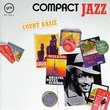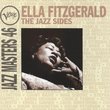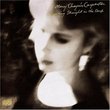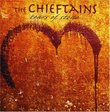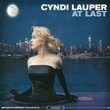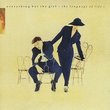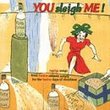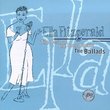| All Artists: Ge Gan-ru Title: Gan-ru: Lost Style Members Wishing: 0 Total Copies: 0 Label: New Albion Records Original Release Date: 1/1/2007 Re-Release Date: 11/24/2009 Genres: Special Interest, Pop, Classical Styles: Vocal Pop, Chamber Music, Historical Periods, Classical (c.1770-1830) Number of Discs: 1 SwapaCD Credits: 1 UPC: 022551013421 |
Search - Ge Gan-ru :: Gan-ru: Lost Style
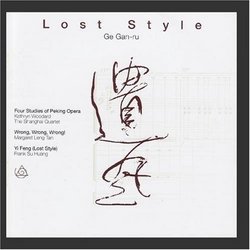 | Ge Gan-ru Gan-ru: Lost Style Genres: Special Interest, Pop, Classical
Gan-ru: Lost Style by Ge Gan-ru |
Larger Image |
CD DetailsSynopsis
Album Description Gan-ru: Lost Style by Ge Gan-ru Similarly Requested CDs
|
CD ReviewsFrom the original spring BB | Whitmore Lake, MI USA | 12/04/2007 (4 out of 5 stars) "Being the holder of a historical distinction must be like having a ball and chain clamped on your ankle. Any mention of Ge Gan-ru is quickly followed by the clanking designation "China's first avant-garde composer." And while I try to listen to Ge's music without this giant badge distracting me, I certainly agree that much credit is due him for becoming a composer at all. When Ge was 11, the Cultural Revolution banned Western music, and he had to play his violin in secret. At 17 he was sent to a re-education camp, where he was forced to play revolutionary music for his fellow re-educatees. By 1980 he was composing advanced music, despite political pressure brought against him. But he persevered, he was talented and he was lucky---he was able to relocate.
In 1983, not long before he came to NYC to study and live, Ge composed "Yi Feng" ("Lost Style") for one of his students. The promotional copies of this CD featured this track first, but the final pressings have it last. You may still want to listen to it first, to see where Ge began. But, while I can applaud the piece as a bold stand, as an interesting first step down the path of comtemporary orchestra music of that era, at this remove it seems a stereotypical beginner's foray into expanded cello dynamics. I hear a vocabulary-building exercise more than anything else. Ge's piece for string quartet and piano, "Four Studies of Peking Opera," written twenty years later, shows that he had not only expanded his vocabulary even further but became fluent in all its nuances. The title and subtitles of this piece ("Prologue," "aria," "Narrative," and "Clown Music") suggest simple program music---the kind of musical onomatopoeia everyone is sick of by the second time they hear "Carnival of the Animals." But there's nothing for the "Pops Concert" here. "Prologue" starts out much like "Yi Feng," with buzzing, rattling and slamming. But where we usually think of slamming as a closing door, here it marks an opening one. The (prepared) piano and the quartet don't so much sketch the moves of actors, as toss their body rhythms back and forth in call and response, and the glissandos suggest sweeping gestures against the stomping dance of the piano, making a music half song and half acrobatics. In "Aria" an achingly operatic melody sets off sympathetic vibrations in instruments and sounds that should short-circuit it, but instead complement and expand on the longing in ways at once traditionally romantic and exotically percussive. At mid-point there is a long passage so suspended in time that the conductor's arms must have lifted high, high, high and just hung there, wide open.... You would be hard pressed to find another pieces of contemporary music as beautiful as this. "Narrative" is once again disjoint, a hocket-style corner-pocket study in percussive clicks and sawings, that manages to suggest spoken Chinese. The closer, "Clown Music," comes closest to traditional program music, but novel sounds (a glass applied to the strings of the piano, most prominently) keeps it mostly fresh to the end. The reason I bought this recording was because I had read that Ge had written a new piece for pianist Margaret Leng Tan. This, a setting of a Chinese poem the title of which translates as "Wrong, Wrong, Wrong," appears between the two string features. In this piece, Ge suggests Chinese tonalities with Tan's toy piano and a table-top toy harp. Tan's toy accordion (which plays only two notes), and dozen-odd little percussion instruments create a tinker-toy-sturdy bridge between Eastern and Western sounds as Tan interacts with one then another. But the most ear-catching sound is, not surprisingly, Tan's voice. Her singing/recitation of the poem, in vocal shapes largely improvised within Ge's structure, is interwoven with the toys, imitating or at times cutting across the timbral grain of the instruments. Tan warbles, growls, sings siren tones with sudden drops in pitch, even croons in greeting to the flutters and wows of the thin toy gongs. Her voice is by turns cradling and territorially canine, and constantly changes husk and color. As strong and fascinating as this performance is on its own, it expands to touch the entire CD. So much of Ge's music here---from the scratchy glissandos to the violin melody that puts rucks in your heart---is based in his hearing of the human voice. To assemble this program with "Wrong,Wrong, Wrong" at the center is like planting a decorative garden around an eternal spring. No matter how exotic the plantings which surround it, no matter how fascinating they grow, we are always reminded that the source of all this, that which gives it life, is the human voice." |

 Track Listings (6) - Disc #1
Track Listings (6) - Disc #1